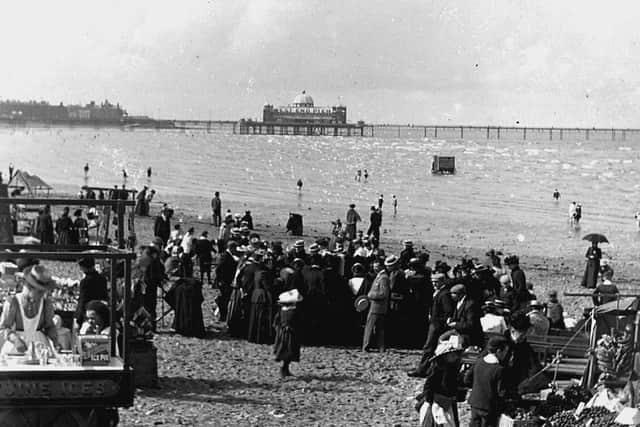Morecambe’s East and West vied for teeming visitors’ attention
and live on Freeview channel 276
In the process, the two halves of the town, separated by railway tracks, engaged in a kind of rivalry, trying to outdo one another with evermore spectacular attractions.
The first salvo was fired with the opening of the Summer Gardens in the West End in 1877. The People's Palace (later to become the Winter Gardens ballroom) was the reply in 1878 from the other side of the tracks.
Advertisement
Hide AdAdvertisement
Hide AdAfter a lull in proceedings, along came the new West End Pier which opened complete with a golden domed pavilion in 1896. This stole a lead on the old Central Pier built simply as a bare landing stage for boats in 1868, and prompted the addition of a pavilion of its known which would come to be known as the Taj Mahal.


Work on the West End Pier began in 1893. The ironwork was specially made, contrasting with that for the Central Pier which was second hand, having been made originally for a pier in Valparaiso on the Pacific coast of Chile.
The West End Pier also brought a pair of architects to Morecambe, John Littlewood and William Mangnall who would design not only the town’s two pier pavilions but also the Winter Gardens theatre and the Metropole Hotel in Heysham.
Initially a great success, the pier was lengthened in 1898 to 1,800 feet to accommodate larger steamers. A storm in 1903 reduced it again and was the first of a series of misfortunes. Fire destroyed the pavilion in a spectacular night time blaze in 1917. Fire struck again and, as many remember, the West End Pier was finally wrecked in the storm of 1977.
Advertisement
Hide AdAdvertisement
Hide AdIn the 1960s Oasis Amusements occupied a plain box-like structure at the landward end of the pier while open air dancing and roller skating were popular end-of-the-pastimes pushing aside the traditional pierrot shows of Ernest Binns’ West End Follies or Herman and Constance Wells’ Royal Follies.


After the 1977 storm the remains of the pier stood as an island still advertising open air dancing, skating and the pier’s lounge bar. Still standing too were a pair of shelters and a few ornate lamp posts, the last survivors of the original pier structure.